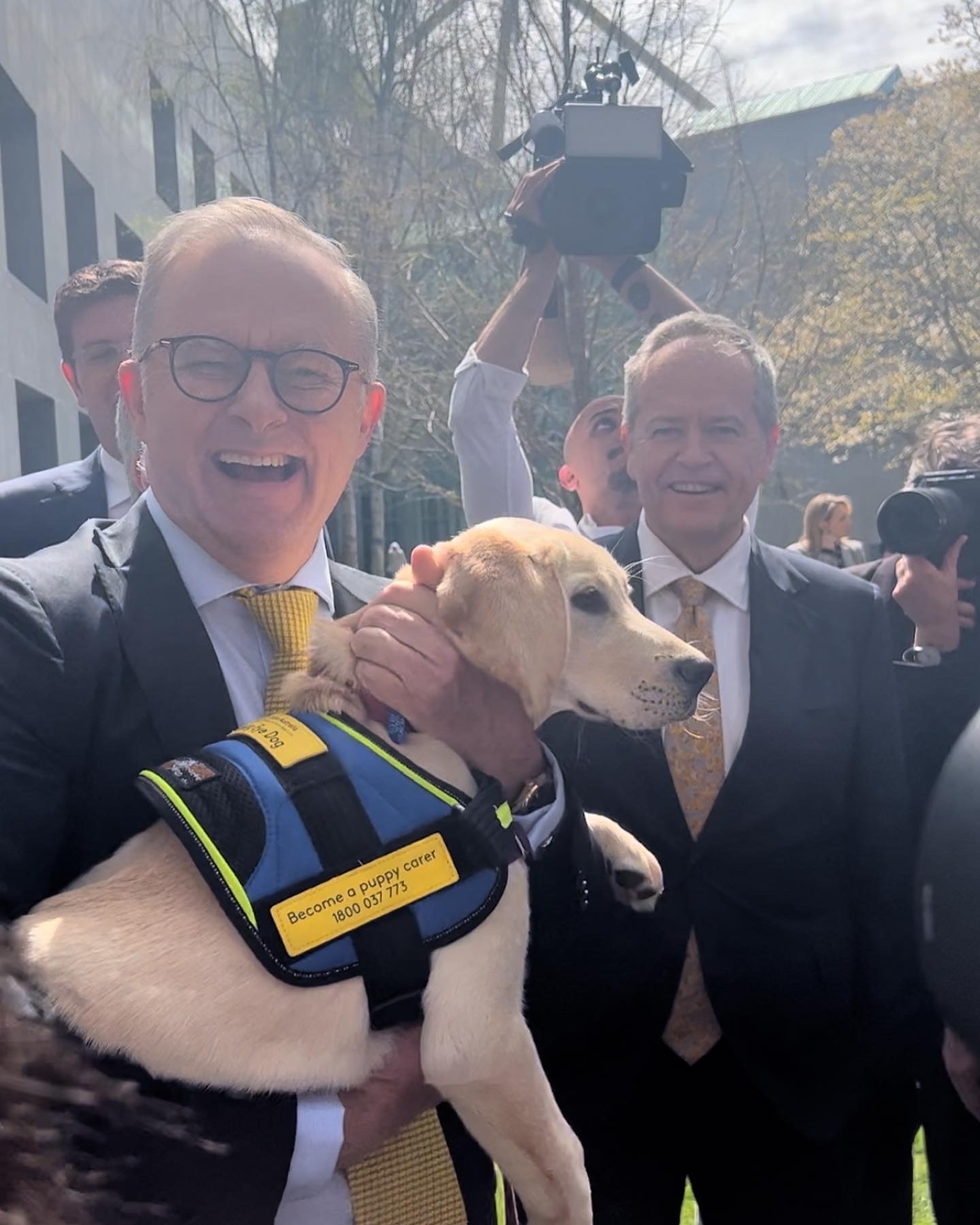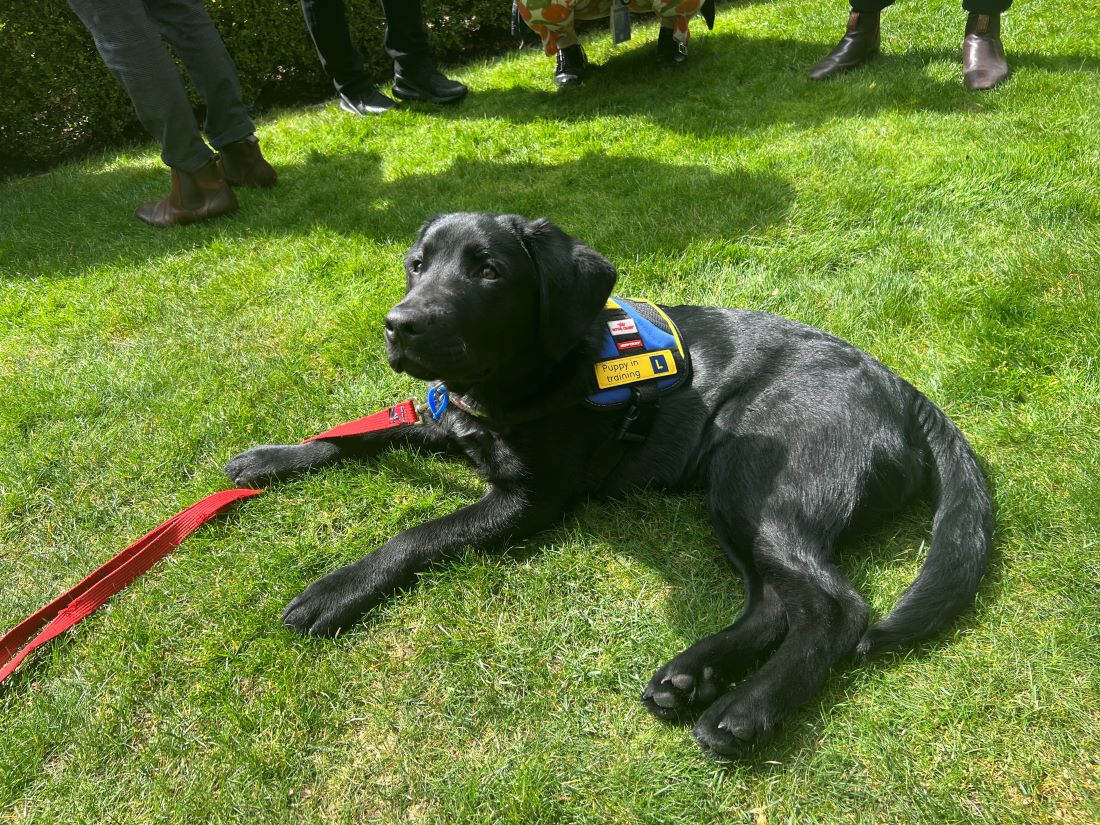Open to all Australians and visitors to see where the decisions that shape our nation are made, Parliament House welcomed some furry visitors this afternoon, Tuesday 12 September. Aiming to raise awareness of the discrimination faced by seeing eye dogs and their handlers, Vision Australia brought pups in training to visit policymakers.
“We still get an unacceptable number of refusals to enter, whether it’s a taxi or rideshare or a restaurant … despite the law being very clear. That has a major impact on people,” says Chris Edwards, Director of Government Relations and Advocacy at Vision Australia.
Not only do vision impaired people face this unfair discrimination, but it is also emotionally taxing on those who rely on these dogs to help them navigate their surroundings, Mr Edwards says. Seeing eye dogs are an incredible tool for people who are blind or vision impaired, providing them with a dedicated, hard-working set of eyes.
Legally, seeing eye dogs can only be denied entry in operating theatres, commercial kitchens and zoos, however, many people face discrimination every day. Mr Edwards says he and his dog Eva get questioned weekly when they are just going about their lives.
“She’s certainly very much a dog that I rely on to have independent mobility to have the confidence to know that I’m safe in the community,” he says. “To be honest, I couldn’t even do my job without Eva. Part of my role in government relations, I need to travel a lot and go to new places and we do that in our stride.”
According to Mr Edwards, seeing eye dogs become an incredibly important part of the lives of their handlers and their families. While he could do things with a cane, such as meeting people in the city or going out, life is better with Eva.
“I know that I can do that as a team with her and it’s something very special and obviously they are great companions, they go everywhere with you,” he says.
Guiding Mr Edwards for the past three years, Eva has some big shoes to fill. His first seeing eye dog, Odie, was the first dog to go on the Senate floor while the Senate was sitting. After eight years with Mr Edwards, Odie retired and Eva was hired. The Edwards family have kept Odie, allowing him to live the rest of his life as a beloved pet. Such a decision is that of the handler.
“You can give it to a friend or family member, which I know lots of people do. Then, if you don’t have that, certainly seeing eye dogs will find a rehome for it to be able to live out its retirement years,” Mr Edwards says.

Lapping up some puppy love were Prime Minister Anthony Albanese and Bill Shorten, Minister for the National Disability Insurance Scheme. Mr Shorten says only the three above-listed venues can restrict access for seeing eye dogs and their owners, and anywhere else doing it isn’t up to scratch.
“Anyone denying access to someone with a seeing eye dog is discrimination. It’s just not on,” Mr Shorten says.
“The NDIS has funded 606 assistance animals across the country. It is the responsibility of all of us to promote a universal culture of acceptance and to stand up for what’s right.”
Enjoying the short reprieve from his daily tasks, Mr Shorten made time to meet two of the pups in training, as well as some handlers and their trained dogs (ensuring to respect the working dogs’ needs).
“Seeing the beautiful eyes of little Homer and Lana today before Question Time reminded me of President S Truman’s sage advice: ‘If you want a friend in politics, get a dog’,” the minister says.
From playful pup to working dog
Being paired with handlers from around 18 months of age, seeing eye pups are bred for the role. Vision Australia has its own breeding program involving Labradors and Golden Retrievers in Melbourne. Each pup enters a 12-month puppy raising program, often in the care of volunteer carers.
“They’re learning the basics of being a puppy – good socialisation, obedience skills, to be calm in busy environments,” says Mikaela Smith, mobility instructor at Vision Australia Seeing Eye Dogs.
At the 12-month mark, the training is turned up a notch with a five-month intensive program.
“They’re learning how to actually guide in harness, learning obstacle avoidance, locating kerbs, targeting locations,” says Ms Smith.
Around this time, the organisation starts looking to match a dog to its handler. As the process is long and dog numbers are limited, it is vital the pair are a perfect match. Vision Australia needs to ensure the future handler has a functional need for the dog that a long cane can’t provide and is able to care for the dog independently.
“They need to have a workload that’s suitable for our dogs because they do go out at 18 months, so an 18-month-old Labrador/Golden Retriever does have a lot of energy and needs to have a number of routes a week to get out and about,” says Ms Smith.
She says the dog’s appearance is also a consideration; Inge, for example, is a Labrador-Golden Retriever cross but has dark markings like a German Shepherd or Rottweiler. Handlers are often denied access to hotels, restaurants and vehicles, but when they have a dog that typically looks like a Labrador, they have a bit more success.
“Inge, being the look that she is, not looking like a typical Labrador, we need to consider matching her to a handler who is going to have that confidence to know their rights and be able to stand up,” says Ms Smith.
Only delivering a high standard to their client, not all dogs that undergo training make the grade; sometimes it is temperament, other times it could be medical, or it just doesn’t work.
“Last year, we actually placed the highest number of dogs that we’ve ever placed. We placed 50 dogs nationally in the last financial year all over Australia, which is exciting and great to see that our program is really successful and that we’re able to provide the support to so many handlers across the nation,” she says.
Vision Australia is currently at capacity with the number of dogs they can train each year but are hoping to see those numbers grow in the future.
“The projections are there are more and more vision impaired people each year who could use them, there is a growing need for them potentially,” says Mark Jackman, senior puppy development trainer.

For a trainee dog that might not get the job of seeing eye dog, Mr Jackman says it’s never hard to find them a place to go, such as working as an assistance dog with another organisation or being adopted as a pet.
With a background in science, Mr Jackman is passionate about the pups. He says Vision Australia couldn’t do it without the help of their volunteer carers, who receive guidance in how to raise the pups and prepare them for their future role – just like the carer raising five-month-old Homer.
“The carer needs to be socialising, basically, Homer goes everywhere with her – to work, shopping, taking her kid to school, all that sort of stuff. That forms a big part of his training,” says Mr Jackman.
“Then she’s also teaching him to work nicely on leads and be well behaved in the home, not too distracted when he’s out on walks. I go out and visit her at home and we meet up in other places and I train her to train the puppy.”
Do not pat a seeing eye dog
Mr Edwards says that although seeing eye dogs look adorable and friendly, members of the public need to ignore the dogs when they are doing their job.
“You don’t talk to them, and you don’t pat them. That’s simply because they’re doing the job of providing mobility, and what we want to ensure is that they continue to do that job without distraction. If the dog learns to go from one person to the next, to accept the pat, that’s not going to work very well for someone like me,” he says.
Get all the latest Canberra news, sport, entertainment, lifestyle, competitions and more delivered straight to your inbox with the Canberra Daily Daily Newsletter. Sign up here.



